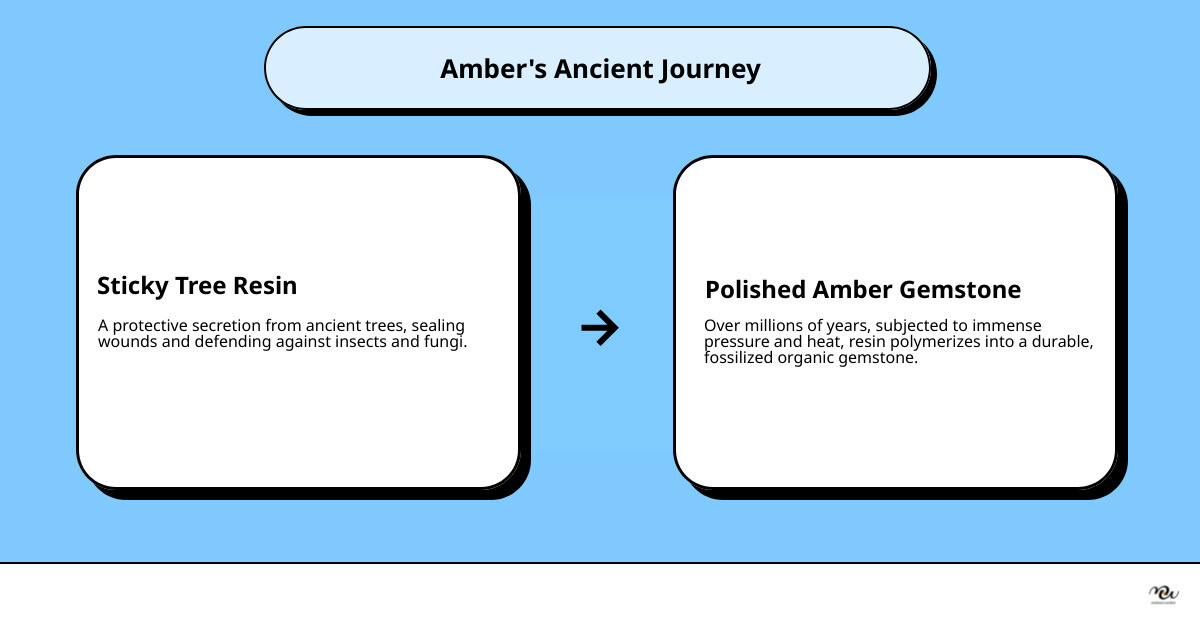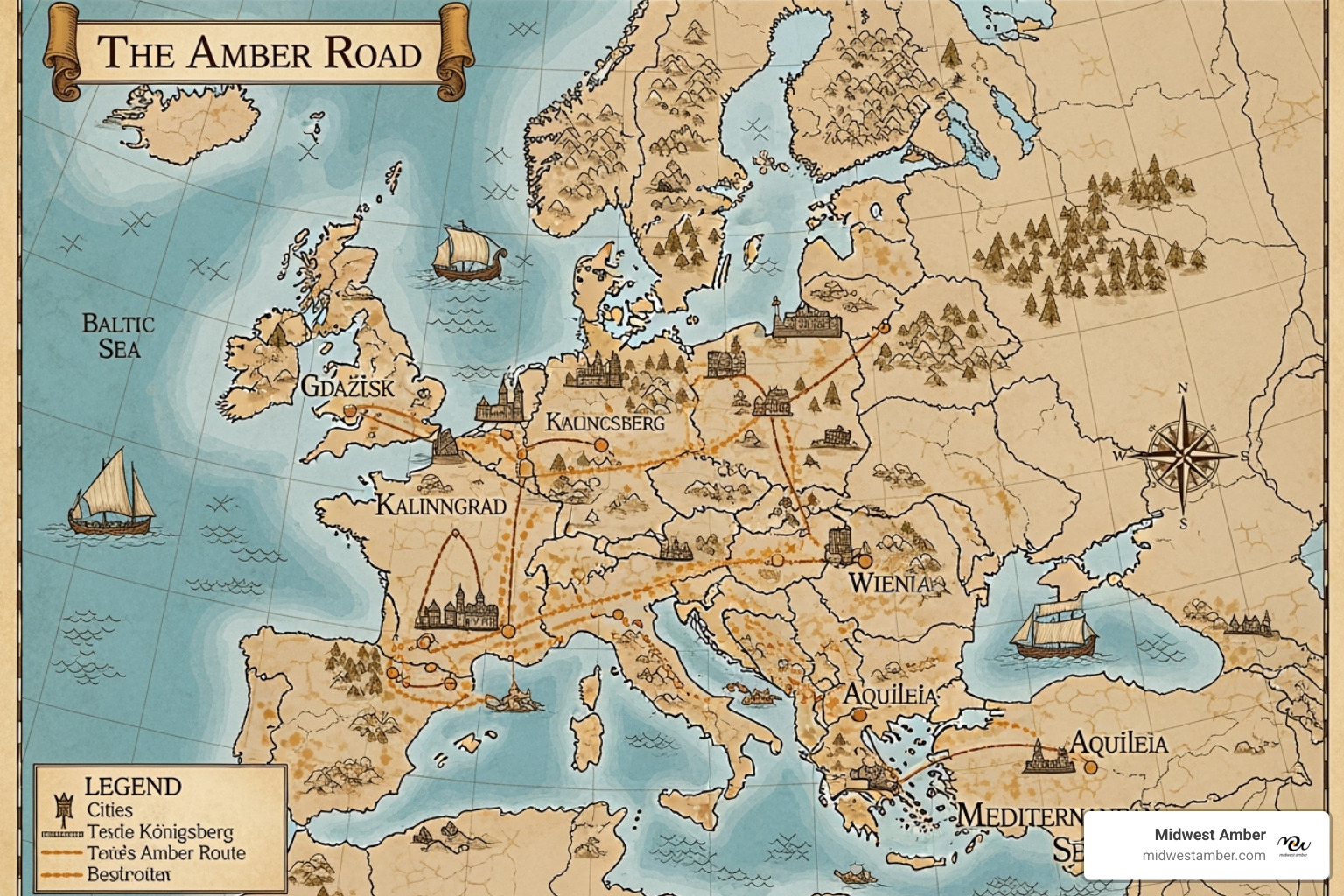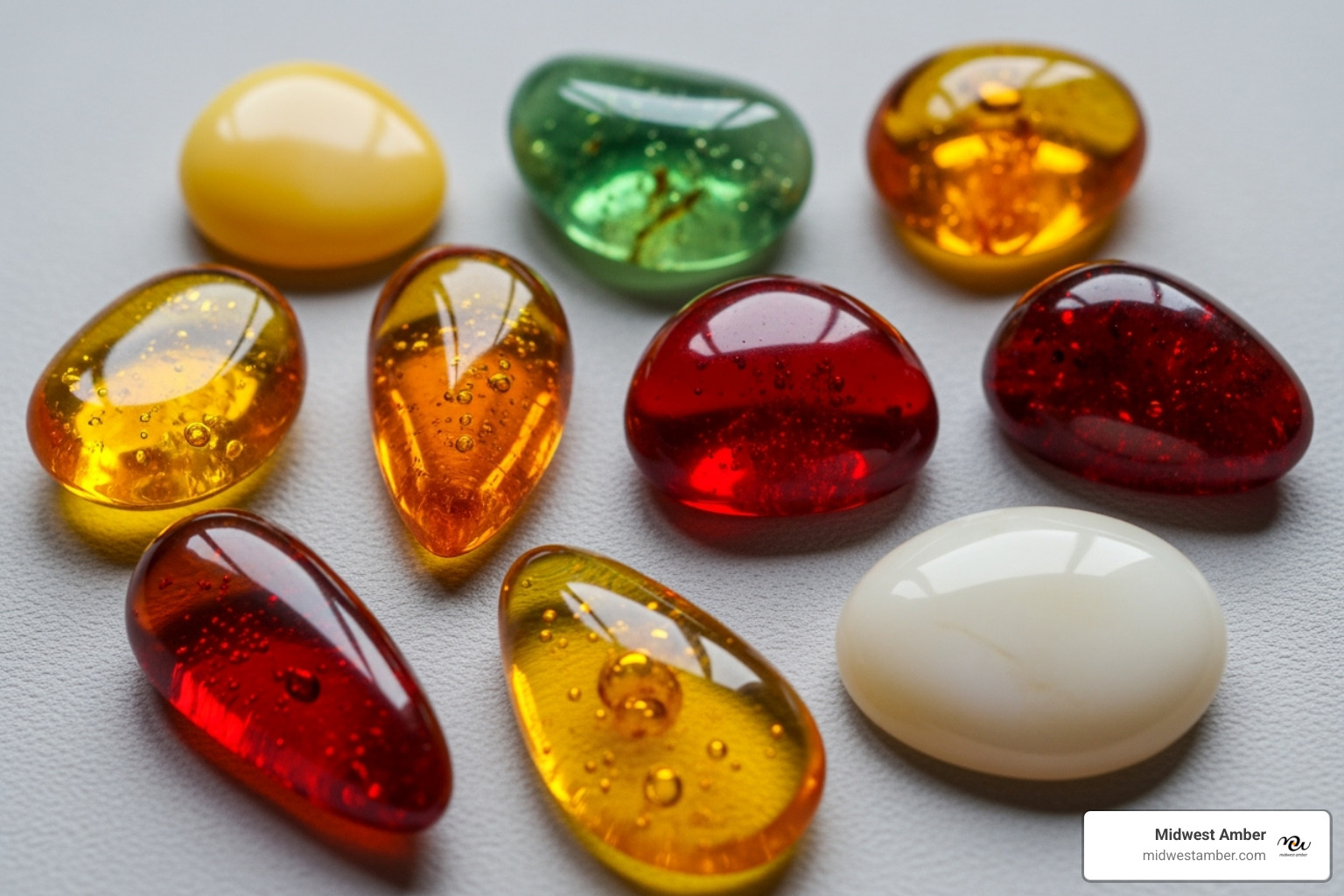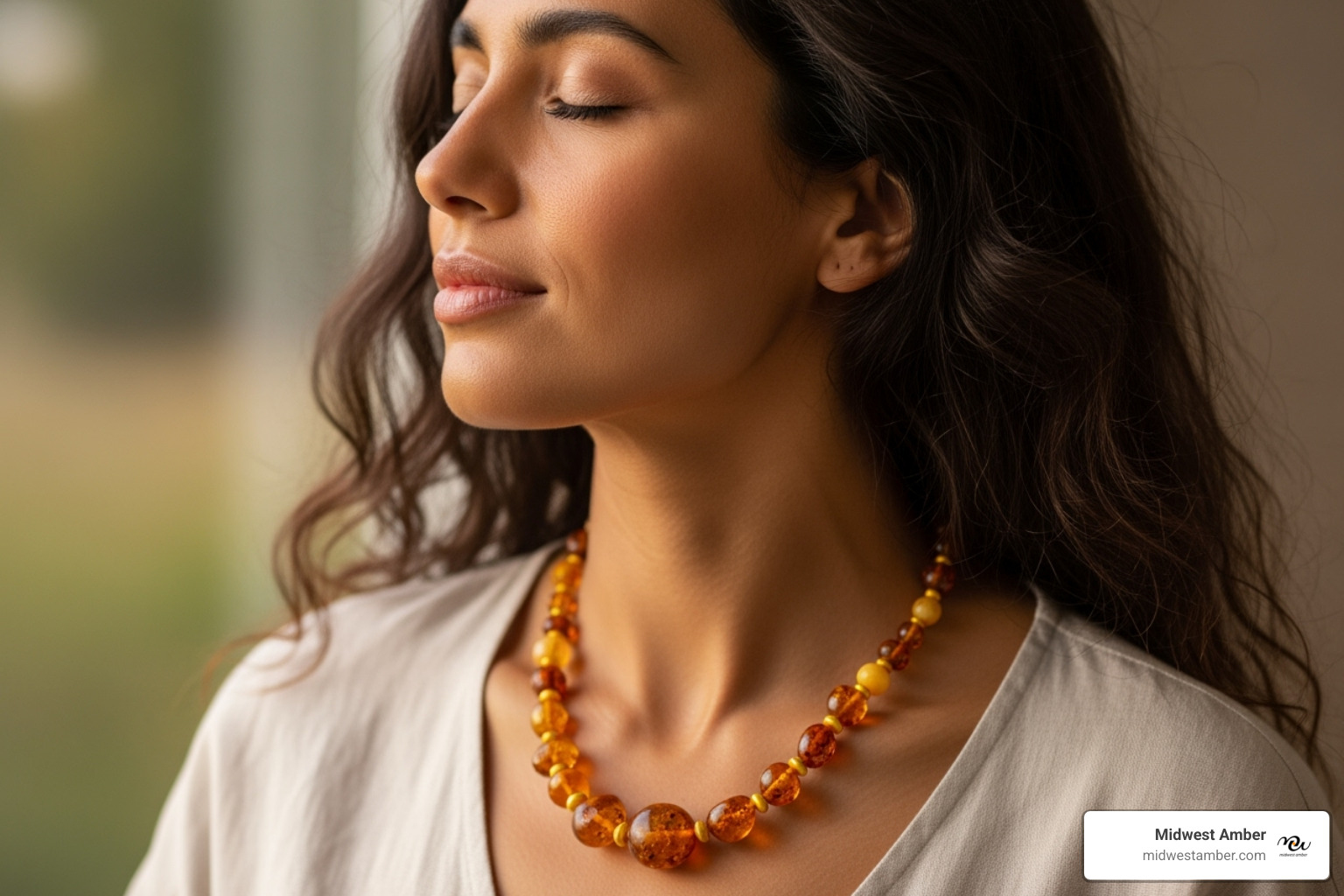Why Amber Crystal Captivates Hearts Worldwide
Amber crystal isn't a crystal at all—it's something more extraordinary. This golden treasure is fossilized tree resin that formed millions of years ago, making it a unique organic gemstone.
Quick Amber Crystal Facts:
- Origin: Fossilized tree resin from ancient forests
- Age: 40-320 million years old
- Composition: 79% carbon, 10.5% hydrogen, 10.5% oxygen
- Hardness: 2.0-2.5 on Mohs scale
- Colors: Over 300 shades from pale yellow to deep red
- Special Properties: Warm to touch, naturally electrostatic
Unlike mineral crystals, amber began as sticky tree sap protecting ancient forests. Over millions of years, this resin hardened and fossilized, sometimes trapping insects, plants, and other prehistoric life within its golden depths.
The oldest amber dates back 320 million years, making each piece a window into Earth's ancient past. Baltic amber, prized for its quality and often called "Baltic Gold," contains 3-8% succinic acid—a compound many believe contributes to amber's healing properties.
I'm Gabriel Ciupek, President and owner of Midwest Amber, Inc., where I've spent years helping people find the timeless beauty of genuine amber crystal jewelry. My experience training teams and working directly with suppliers has given me deep insight into what makes authentic amber so extraordinary.

What is Amber and How Is It Different From Crystals?
When you hold a piece of amber crystal, it feels different from other gemstones. It's warm, lightweight, and seems to glow with an inner light. That's because amber isn't a crystal—it's something more extraordinary.
Millions of years ago, when ancient trees were injured, they would bleed a sticky, golden resin to protect themselves. This resin hardened, sometimes trapping tiny insects, leaves, or air bubbles inside. Buried under layers of earth, pressure and heat slowly fossilized the resin through a process called polymerization, turning it into the beautiful amber crystal we know today.
Amber's chemical makeup is unique. It's made of about 79% carbon, 10.5% hydrogen, and 10.5% oxygen—all organic materials from living trees. This is completely different from mineral crystals, which form from non-living geological processes.
| Feature | Amber | Mineral Crystals |
|---|---|---|
| Origin | Fossilized organic tree resin | Inorganic minerals formed geologically |
| Composition | Hydrocarbon material (C, H, O) | Specific chemical compounds (e.g., SiO2) |
| Hardness (Mohs) | 2.0 - 2.5 (relatively soft) | Varies widely, often harder (e.g., Quartz 7, Diamond 10) |
| Structure | Amorphous (no fixed internal crystal lattice) | Crystalline (regular, repeating atomic structure) |
| Classification | Organic gemstone (or mineraloid) | Mineral gemstone |
This organic origin makes amber crystal a mineraloid, not a true mineral. It lacks the regular, repeating atomic structure of crystals, making it amorphous—its molecules are arranged randomly.
If you want to dive deeper into the fascinating science behind how amber forms, you can learn more about the science behind amber's formation.
The Ancient Origins of Amber
The journey of amber crystal began in ancient forests of now-extinct pine trees. Most amber we see today formed between 40 to 120 million years ago during the Eocene epoch. The most ancient piece ever found dates back an incredible 320 million years to the Carboniferous period, finded in an Illinois coal mine in 2009.
The trees that created Baltic amber—the type we specialize in at Midwest Amber—were called Pinus succinifera. These extinct conifers once covered vast areas of what is now Northern Europe, producing the "liquid gold" that became the stunning amber jewelry we treasure today.
Amber's Unique Physical Properties
Amber crystal has amazing properties that make it special. It's quite soft, rating only 2.0 to 2.5 on the Mohs hardness scale, so you should handle your amber jewelry gently.
One of amber's most delightful properties is how warm it feels against your skin. Unlike cold gemstones, it has a pleasant, lightweight feel due to its low specific gravity. In fact, amber is so light it can float in saltwater!
When you rub amber crystal, it builds up static electricity. This electrostatic property was first noticed by the ancient Greeks, who called amber "ēlektron." Our modern words "electric" and "electricity" come from this Greek word for amber.
To see amber's preserving power in action, check out this incredible find of a dinosaur tail found in amber. It shows how perfectly amber can capture life from millions of years ago.
The Global Reach and Rich History of Amber

The story of amber crystal is a global one. While the Baltic Sea region—including Russia, Lithuania, and Poland—produces about 90% of the world's amber, this treasure is found worldwide. Deposits exist in the Dominican Republic (home to rare blue amber), Myanmar (Burma) (some of the oldest specimens), and other countries like Mexico and Ukraine. Each region's amber reflects its unique ancient forests.
Amber's true magic lies in its incredible historical significance. People have been captivated by amber crystal for over 12,000 years, since Neolithic times. The ancient Greeks and Romans crafted it into jewelry and amulets. The Roman writer Pliny the Elder correctly deduced that amber was fossilized tree resin by observing the insects trapped inside.
The legendary Amber Road, a trade network connecting the Baltic coast to the Mediterranean, is a testament to amber's value. For centuries, merchants transported this "northern gold" to eager buyers, showing how precious it was.
Notable Historical Uses and Finds
Throughout history, amber crystal was more than jewelry; it was used for medicine, protection, and as a window to the past. Ancient peoples crafted amber into amulets and talismans to ward off evil and bring luck. Its value is confirmed by amber jewelry found in ancient Mycenaean and Egyptian tombs.
The medicinal uses of amber in folk traditions are fascinating. Ancient Chinese medicine used amber powder for various ailments, and Martin Luther reportedly carried it to prevent kidney stones. While parents used amber necklaces for teething, modern safety guidelines now advise against this practice due to choking hazards.
For scientists, amber crystal is a time capsule. It preserved ancient life with incredible detail, with over 1,300 species found in Burmese amber alone. These prehistoric treasures include insects, plant matter, small vertebrates, feathers, and air bubbles from ancient atmospheres. The most exciting finds, like parts of a dinosaur tail, offer paleontologists unparalleled insights into prehistoric ecosystems.
For more captivating stories and insights into this remarkable organic gemstone, we invite you to Read more on our Amber News blog.
A Guide to Amber Types, Colors, and Quality

People are often surprised that amber crystal comes in over 300 different shades, not just the familiar honey-golden glow. The classic golden-yellow and orange tones come from oxidation and trapped air bubbles. But amber holds many more surprises.
Breathtaking colors include rare blue amber from the Dominican Republic, which glows under UV light. Green amber gets its color from ancient swampy environments. Red amber, or "Cherry Amber," develops deep burgundy tones from prolonged exposure to air or heat, while black amber is packed with organic inclusions. White amber, or "Royal Amber," has a creamy, opaque beauty. The color of amber crystal depends on the original tree species, fossilization conditions, and what was trapped inside.
Different Types of Amber
Different regions produce amber crystal with distinct characteristics shaped by their ancient environments.
Baltic Amber, also known as Succinite, is the crown jewel of the amber world. Sourced from the Baltic Sea region, it's renowned for exceptional quality and contains 3-8% succinic acid, which many believe contributes to its healing properties. At Midwest Amber, we're proud to specialize in handcrafted, genuine Baltic amber jewelry, ethically sourced from Poland and Lithuania.
Dominican Amber is famous for its clarity and incredible inclusions of perfectly preserved insects and plants. It's also the primary source of rare blue amber.
Burmese Amber, or Burmite, from Myanmar is one of the oldest types, at around 99 million years old. Scientists treasure it for its abundance of well-preserved prehistoric life.
Determining Amber Quality and Value
Understanding what makes amber crystal valuable helps you appreciate these treasures. Clarity plays a major role, but sometimes inclusions make a piece far more valuable. A piece with a well-preserved insect or plant is a window into prehistory and can dramatically increase its value.
Size, shape, and color rarity are also key factors, with blues, greens, and deep cherry reds commanding higher prices. Authenticity is crucial. At Midwest Amber, we guarantee our Baltic amber is 100% genuine. To test amber at home, try the saltwater test: genuine amber floats in a solution of two parts water to one part salt. The scent test also works: gently warmed real amber has a pine-like aroma, while plastic smells burnt.
Real amber crystal feels warm to the touch, unlike cold glass or plastic. Choosing authentic amber jewelry means you're getting a certified piece of ancient history.
The Healing Power of the Amber Crystal

Holding a piece of amber crystal feels magical. It's warmer and more alive than other stones. For thousands of years, people have sought its healing energy, connected to the sun's warmth. Wearing amber crystal is like carrying ancient sunshine. This golden treasure is said to radiate positivity, cleanse negative energy, boost confidence, and dispel fear. The warmth is also emotional and spiritual, helping many feel more grounded and centered.
Physical Healing Properties
While not a substitute for professional medical advice, amber crystal has a long history as a healing talisman. The key to Baltic amber crystal is succinic acid (3-8% of its composition). When worn against the skin, body warmth may release tiny amounts of this acid, which many believe is the source of its healing powers.
Pain relief is amber's most famous property. Adults often use amber crystal for joint pain, arthritis, and headaches. Its anti-inflammatory properties make it a popular choice for chronic pain. Beyond pain relief, amber crystal is believed to boost the immune system and support the body's natural detoxification processes.
Metaphysical Properties of the Amber Crystal
In energy healing, amber crystal is like sunshine for the spirit. It's believed to energize the Solar Plexus Chakra (your center of confidence) and open the Sacral Chakra (governing creativity and passion). Amber crystal can act as an emotional reset, absorbing stress and anxiety and replacing worry with optimism. It's said to help release old emotional baggage. Artists and writers have long treasured it for its creative boost. As a protective shield, it's believed to guard against negative influences.
How to Use Your Amber Crystal for Wellness
It's easy to welcome amber's energy into your daily life.
Wearing amber jewelry is the most popular way to enjoy its benefits, allowing direct contact with your skin. This is why we put so much care into every piece of Baltic amber jewelry at Midwest Amber.
Placing amber pieces in your home can bring grounding energy. In Feng Shui, it's used to purify spaces and clear negativity.
For meditation, hold a smooth piece of amber to calm your thoughts and connect with its stabilizing energy. Many find it clarifies intuition and deepens focus.
For anxiety, use amber as a worry stone. Rubbing a smooth piece can be very soothing.
To keep your amber crystal energetically fresh, rinse it under cool water and dry it with a soft cloth. Recharge it in moonlight or a few hours of indirect sunlight, avoiding prolonged exposure to prevent fading.
Frequently Asked Questions about Amber
After years of helping customers find the beauty of amber crystal, I've noticed the same thoughtful questions come up again and again. Let me share the answers to the most common ones we hear at Midwest Amber.
Is amber really a crystal?
Technically, amber crystal isn't a crystal. True crystals like quartz have an organized, repeating atomic structure. Amber is an "amorphous solid," meaning its structure is random. As fossilized tree resin, it's classified as a "mineraloid," not a true mineral. However, in metaphysical practices, the term amber crystal is widely used and understood because it's used for similar purposes as traditional crystals.
What is the rarest color of amber?
Blue amber is the rarest and most valuable color. This extraordinary variety is found almost exclusively in the Dominican Republic. Under normal light, it can look golden, but under UV light or against a dark background in sunlight, it reveals an incredible blue fluorescence. Only about 100 kilograms of blue amber crystal are found annually worldwide, making it highly sought after by collectors.
Can I get my amber wet?
Yes, you can safely get your amber crystal wet for short periods, like when cleaning it. However, avoid prolonged exposure. Hot water, chlorine, or harsh chemicals can dull its polish and make it brittle over time. To preserve your amber crystal jewelry from Midwest Amber, remove it before showering, swimming, or doing dishes. This will help maintain its natural luster. If you need to clean your amber, lukewarm water and a soft cloth work perfectly.
Accept the Ancient Warmth of Amber
Holding a piece of amber crystal is a magical experience. You're not just touching a gemstone; you're connecting with a piece of Earth's history that has traveled through millions of years to reach you.
We've finded that amber crystal is more than a beautiful stone. It's a bridge to the ancient world, carrying the essence of prehistoric forests. From ancient trees to modern artisans, amber tells a story of preservation and enduring beauty.
What makes amber crystal special is its blend of science and human connection. Its organic origins and unique properties—from its warmth to its ability to preserve ancient life—showcase nature's boundless creativity. Whether you're drawn to its positive energy, rich history, or simple beauty, you're joining a thousands-year-old tradition.
At Midwest Amber, we know choosing authentic amber crystal jewelry is about inviting ancient wisdom and beauty into your life. Our genuine, ethically sourced Baltic amber from Poland and Lithuania is backed by over 20 years of experience and carries the timeless energy that has captivated hearts for centuries. Each piece in our collection reflects our commitment to authenticity and quality. When you choose our handcrafted jewelry, you're carrying a piece of Earth's ancient story.
Ready to experience the ancient warmth for yourself? Find our collection of authentic Baltic amber jewelry and let this remarkable organic gemstone illuminate your journey with its golden light and timeless energy.




Leave a comment
This site is protected by hCaptcha and the hCaptcha Privacy Policy and Terms of Service apply.